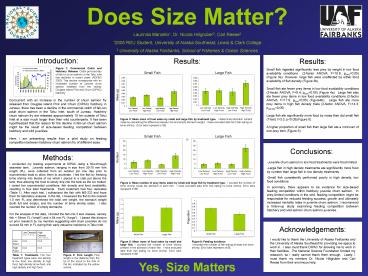Does Size Matter? - PowerPoint PPT Presentation
1 / 1
Title:
Does Size Matter?
Description:
I fed the fish by freezing brine shrimp into blocks of ice which I placed in a ... I counted the number of brine shrimp present in the stomach of each fish. ... – PowerPoint PPT presentation
Number of Views:44
Avg rating:3.0/5.0
Title: Does Size Matter?
1
Does Size Matter?
Laurinda Marcello1, Dr. Nicola Hillgruber2, Carl
Reese2 12005 REU Student, University of Alaska
Southeast Lewis Clark College 2 University of
Alaska Fairbanks, School of Fisheries Ocean
Sciences
Introduction
Results
Figure 1 Commercial Catch and Hatchery Release
Catch-per-boat-day of fall-run chum salmon in the
Taku Inlet has declined in recent years (ADFG
2003). This decline corresponds with an increased
number of juvenile chum salmon released from the
nearby Douglas Island Pink and Chum (DIPAC)
hatchery.
Concurrent with an increase in the number of chum
salmon fry released from Douglas Island Pink and
Chum (DIPAC) hatchery in Juneau, there has been a
decline in the commercial catch of fall-run adult
chum salmon in the Taku Inlet, south of Juneau.
Hatchery chum salmon fry are released
approximately 15 km outside of Taku Inlet at a
size much larger than their wild counterparts. It
has been hypothesized that the reason for the
decline in fall-run chum salmon might be the
result of size-based feeding competition between
hatchery and wild juveniles. Here, I am
presenting results from a pilot study on feeding
competition between hatchery chum salmon fry of
different sizes.
Conclusions
Methods
-Juvenile chum salmon in low food treatments were
food limited. -Large fish in high density
treatments ate significantly more food by number
than large fish in low density treatments.
-Small fish consistently performed poorly in
high density, low food conditions. In summary,
there appears to be evidence for size-based
feeding competition within hatchery juvenile chum
salmon. In prey-limited conditions in the wild,
feeding competition might be responsible for
reduced feeding success, growth and ultimately
increased mortality rates in juvenile chum
salmon. I recommend a follow-up study examining
feeding competition between hatchery and wild
salmon chum salmon juveniles.
I conducted my feeding experiments at DIPAC using
a flow-through seawater tank. Juvenile salmon,
ranging in size from 35-70 mm fork length (FL),
were collected from an outdoor pin one day prior
to experimental trials to allow them to
acclimate. I fed the fish by freezing brine
shrimp into blocks of ice which I placed in a
crab pot above the tank, thus allowing the food
to slowly drip into the tank as the ice melted. I
varied two experimental conditions fish density
and food availability, resulting in four total
treatments. Each treatment had four replicates
(Table 1). After each trial, I euthanized the
fish with MS-222 and froze them for laboratory
analysis. In the lab, I measured the fish to the
nearest 1.0 mm FL and determined the total wet
weight, the stomach weight (both full and empty),
and the number of brine shrimp eaten. I also
counted the number of empty stomachs. For the
analysis of the data, I divided the fish into 2
size classes, namely fish lt 54mm FL (small) and
54 mm FL (large). I based this division on
prior research by my mentors suggesting wild chum
juveniles do not exceed 54 mm in FL during their
early estuarine residence in Taku Inlet.
Acknowledgements
I would like to thank the University of Alaska
Fairbanks and the University of Alaska Southeast
for providing me space to work in. I also must
thank DIPAC for allowing me to work in their
facilities. The National Science Foundation
funded my research, so I really cannot thank them
enough. Lastly, I must thank my mentors Dr.
Nicola Hillgruber and Carl Reese from their
enormous help.
Table 1 Treatments The four treatment types
were low density low food, low density high
food, high density low food, and high density
and high food.
Figure 2 Fork Length Fork length is the distance
from the tip of the snout to the fork of the
tail, indicated by the yellow arrows.
Yes, Size Matters































